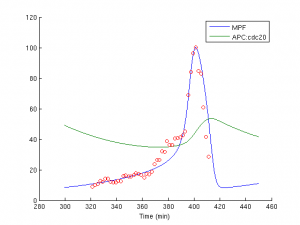Biological context. Mammalian cells have evolved highly sophisticated intracellular communication pathways to enable their development and growth, under multiple environmental stresses and stimulus (nutrition availability, temperature or light changes, etc.). Two major cyclic processes are at the basis of cell development: the cell cycle and the circadian clock, both of which have been separately studied and dissected from many diverse points of view. Circadian disruption is increasingly recognized as a risk factor for the development of malignant disorders, while cell cycle deregulation is a hallmark of cancer cells. Thus, it becomes critical to understand the links between the cell cycle and circadian clock oscillators and the relevance of their coupling for biological and pathophysiological aspects.
A control theoretic problem. From a mechanistic point of view, the interaction between cell cycle and circadian clock can be represented as a control theoretic problem, with an input/output system and its controller. Directly studying the mechanisms of interaction between these two cellular modules is a most challenging task, due to the intrinsic complexity of the networks, the difficulty in isolating specific events in a “natural” cell, and the demanding experimental techniques.
A synthetic biology approach. In ICycle we propose to circumvent these difficulties by combining a control theory interpretation with a synthetic biology approach: first, mathematically design two circuits to exhibit dynamical behaviors similar to the two mammalian oscillators and then synthetically assemble those circuits from molecular components DNA sequences, proteins, or metabolites) to verify and confirm or invalidate the hypothesized mechanism.
Objectives.(i) obtain a set of minimal mathematical models to represent the cell cycle and the circadian clock, mimic their oscillatory behavior and study possible interconnection mechanisms. This will provide a computational platform for numerical analysis and in silico synthetic biology experiments; (ii) design control theoretical strategies for coupling two biological oscillators, control the strength of their interconnection, and the mutual regulation of their frequencies and phases; and, finally, (iii) generate a mammalian cell line which robustly expresses two minimal oscillators, using both transcriptional and translational control.


